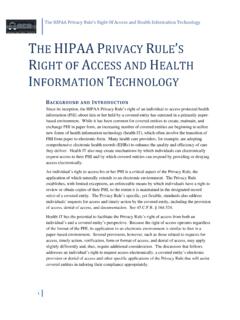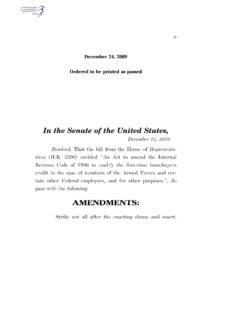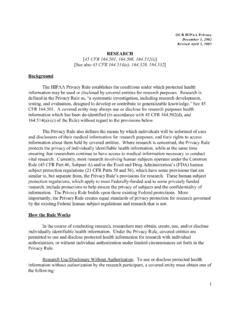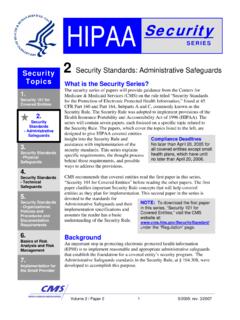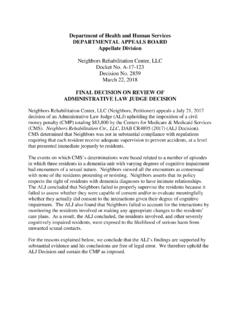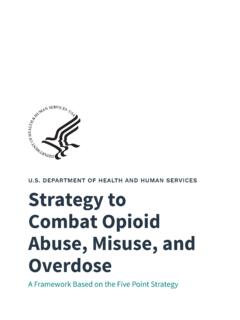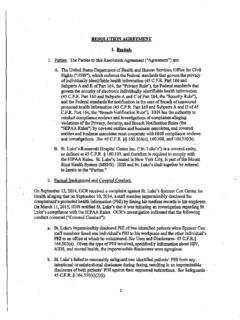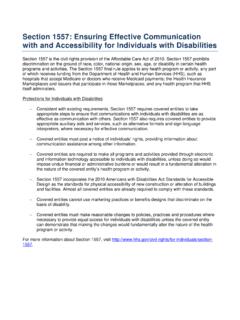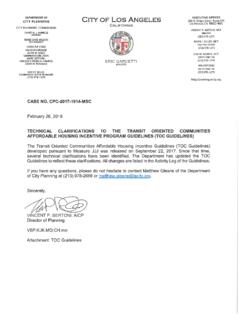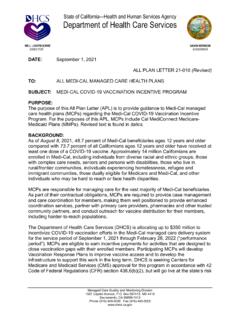Transcription of MERIT-BASED INCENTIVE PAYMENT SYSTEM (MIPS)
1 MERIT-BASED INCENTIVE PAYMENT SYSTEM (MIPS)2020 Promoting Interoperability Performance Category Quick Start GuideUpdated: 6/21/20212 Reweighting the Cost Performance Category to 0% for the 2020 Performance PeriodUPDATED 5/20/2021 CMS is reweighting the Cost performance category from 15% to 0% for the 2020 performance period for all MIPS eligible cliniciansregardless of participation as an individual, group, virtual group or APM Entity. The 15% Cost performance category weight will be redistributed to other performance categories in accordance with (c)(2)(ii)(D). As a reminder, under (c), if a MIPS eligible clinician is scored on fewer than 2 performance categories (meaning 1 performance category is weighted at 100% or all performance categories are weighted at 0%), they will receive a final score equal to the performance threshold and a neutral MIPS PAYMENT adjustment for the 2022 MIPS PAYMENT year.
2 This reweighting of the Cost performance category applies in addition tothe extreme and uncontrollable circumstances (EUC) policy under (c)(2)(i)(A)(6), (c)(2)(i)(A)(8), (c)(2)(i)(C)(2), and (c)(2)(i)(C)(3). Clinicians who aren t covered by the automatic EUC policy or who didn t apply to request reweighting under the EUC will still have their Cost performance category weighted to 0%. For more information about this policy and a table that includes reweighting scenarios,please refer to the QPP listserv, distributed on 5/20/2021. The updated weights for the 2020 MIPS performance categories are as follows:Qualityof MIPSS coreCost0%of MIPSS coreImprovement Activities15%of MIPSS corePromoting Interoperabilityof MIPSS core30%55%3 ContentsHow to Use This Guide4 Overview6 What is the MERIT-BASED INCENTIVE PAYMENT SYSTEM ?
3 7 What is the Promoting Interoperability Performance Category?8 What s New with Promoting Interoperability in 2020?9 Get Started with Promoting Interoperability in Five Steps10 Step 1. Understand Your Reporting Requirements12 Step 2. Review the CEHRT Requirements14 Step 3. Review the Measures and Performance Period Requirements15 Step 4. Perform or Review a Security Risk Analysis15 Step 5. Submit Your Data16 Help, Resources, and Version History19 Appendix23 Already know what MIPS is? Skip ahead by clicking the links in the Table of ContentsPurpose: This resource focuses on the Promoting Interoperability performance category, providing high-level requirements about data collection and submission for the 2020 performance period.
4 This resource does not review requirements for MIPS Alternative PAYMENT Model (APM) participants scored under the APM Scoring Standard. COVID-19 and 2020 Participation: For the 2020 performance year, we will be using our Extreme and Uncontrollable Circumstances policy to allow MIPS eligible clinicians, groups, and virtual groups to submit an applicationrequesting reweighting of one or more MIPS performance categories to 0%. We have introduced a new high-weighted COVID-19 clinical trials improvement activity, which provides an opportunity for clinicians to receive credit in MIPS. For more information about the impact of COVID-19 on Quality PAYMENT Program participation and additional flexibilities proposed in the 2021 QPP Proposed Rule on Quality PAYMENT Program participation, see the Quality PAYMENT Program COVID-19 Response to Use This Guide5 How to Use This GuidePlease Note: This guide was prepared for informational purposes only and is not intended to grant rights or impose obligations.
5 The information provided is only intended to be a general summary. It is not intended to take the place of the written law, including the regulations. We encourage readers to review the specific statutes, regulations, and other interpretive materials for a full and accurate statement of their of ContentsThe table of contents is interactive. Click on a chapter in the table of contents to read that section. You can also click on the icon on the bottom left to go back to the table of to the QPP websiteare includedthroughout the guide to direct the reader to moreinformation and is the MERIT-BASED INCENTIVE PAYMENT SYSTEM ?The MERIT-BASED INCENTIVE PAYMENT SYSTEM (MIPS) is one way to participate in the Quality PAYMENT Program (QPP), a program authorized by the Medicare Access and CHIP Reauthorization Act of 2015 (MACRA).
6 The program changes how we reimburse MIPS eligible clinicians for Part B covered professional services and rewards them for improving the quality of patient care and outcomes. Under MIPS, we evaluate your performance across four categories that lead to improved quality and value in our healthcare SYSTEM . If you re eligible for MIPS in 2020: You generally have tosubmit data for the Quality, Improvement Activities, and Promoting Interoperability performance categories. (We collect and calculate data for the Costperformance category for you.) Your performance across the MIPS performance categories, each with a specific weight, will result in a MIPS final score of 0 to 100 points. Your MIPS final score will determine whether you receive a negative, neutral, or positive MIPS PAYMENT adjustment.
7 Your MIPS PAYMENT adjustment is based off your performance during the 2020 performance period and applied to payments for covered professional services beginning on January 1, 2022. To learn more about how to participate in MIPS: Visit the How MIPS Eligibility is DeterminedandIndividual or Group Participationweb pages on the Quality PAYMENT Program website. View the 2020 MIPS Eligibility and Participation Quick Start Guide. Check your current participation status using the QPP Participation Status is the MIPS Promoting Interoperability Performance Category?Interoperability, or the use of technology to exchange and make use of information, makes communicating patient information lessburdensome and improves outcomes.
8 The MIPS Promoting Interoperability performance category emphasizes the electronic exchangeofhealth information using certified electronic health record technology (CEHRT) to improve: Patient access to their health information; The exchange of information between providers and pharmacies; and The systematic collection, analysis, and interpretation of healthcare : We are reweighting the Cost performance category to 0% for all MIPS eligible clinicians regardless of participation as an individual, group, virtual group or APM Entity. When no additional reweighting applies, the 2020 MIPS performance category weights are as follows: Quality: 55%, Cost: 0%, Improvement Activities: 15%, Promoting Interoperability: 30%.
9 We are leaving the content in this guide as-is for historical s New with Promoting Interoperability in 2020? Groups and virtual groups qualify for automatic reweighting of this performance category when more than 75% of the clinicians in the group or virtual group are hospital- based . We ve removed the Verify Opioid Treatment Agreement measure. The optional Query of Prescription Drug Monitoring Program (PDMP) measure requires a yes/no responseinstead of a numerator and denominator. We finalized this for both the 2019 and 2020 performance periods in the Calendar Year (CY) 2020 QPP Final Started with Promoting Interoperability in Five Steps11 Get Started with Promoting Interoperability in Five StepsStep 1 Step 2 Step 3 Understand Your Reporting RequirementsReview the CEHRT RequirementsReview the Measures and Performance Period RequirementsANY TIMEANY TIMEU ntil December 31, 2020 Step 4 Perform or Review a Security Risk AnalysisUntil December 31, 2020 Step 5 Submit Your DataJanuary 4 March 31, 202112 Step 1.
10 Understand Your Reporting RequirementsCertain MIPS eligible clinicians and groups are not required to report data for this performance category. In this case, the category weight (or contribution to your final score) is redistributed to another performance category (or categories) unless they choose to submit data. MIPS eligible clinicians, groups and virtual groups that qualify for reweighting will be scored in this performance category if they submit any Promoting Interoperability performance category as an individual?Check the QPP Participation Status Lookup Toolor sign in to any special statuses assigned at the Clinician Level. Reporting as a group?Check the QPP Participation Status Lookup Toolor sign in to for any special statuses assigned at the Practice as a virtual group?
